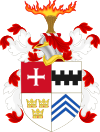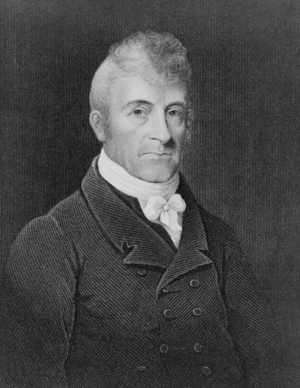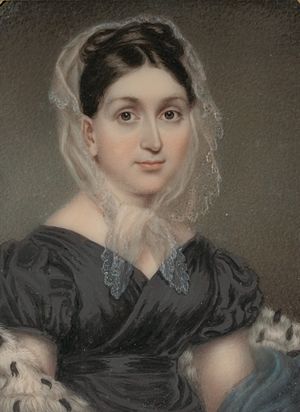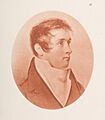Stephen Van Rensselaer facts for kids
Quick facts for kids
Stephen Van Rensselaer
|
|
|---|---|
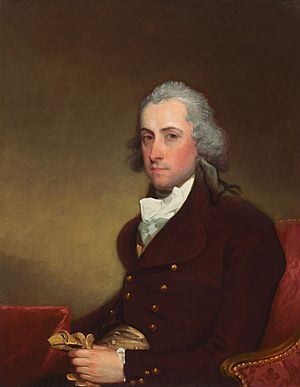 |
|
|
Stephen Van Rensselaer III, c. 1790s, by Gilbert Stuart
|
|
| Member of the U.S. House of Representatives from New York |
|
| In office March 12, 1822 – March 3, 1829 |
|
| Preceded by | Solomon Van Rensselaer |
| Succeeded by | Ambrose Spencer |
| Constituency | 9th district (1822–1823) 10th district (1823–1829) |
| Lieutenant Governor of New York | |
| In office 1795–1801 |
|
| Governor | John Jay |
| Preceded by | Pierre Van Cortlandt |
| Succeeded by | Jeremiah Van Rensselaer |
| Member of the New York State Senate from the Western District, at-large | |
| In office 1791–1796 |
|
| Member of the New York State Assembly from the Albany County district, at-large | |
| In office 1789–1791 |
|
| Grand Master of the Masonic Grand Lodge of New York | |
| In office 1825–1829 |
|
| Preceded by | Joseph Enos |
| Succeeded by | Morgan Lewis |
| 9th Patroon and 6th Lord of the Manor of Rensselaerswyck | |
| In office 1769–1839 |
|
| Preceded by | Stephen Van Rensselaer II |
| Succeeded by | Stephen Van Rensselaer IV |
| Personal details | |
| Born | November 1, 1764 New York City, Province of New York, British America |
| Died | January 26, 1839 (aged 74) New York City, U.S. |
| Resting place | Albany Rural Cemetery, Menands, New York |
| Political party | Federalist Adams Republican |
| Spouses |
Margarita "Peggy" Schuyler
(m. 1783; Cornelia Paterson
(m. 1802) |
| Children | 12, including Stephen, Cortlandt and Henry |
| Relatives | See Van Rensselaer family |
| Alma mater | Harvard College |
| Profession | Landowner Businessman |
| Net worth | USD $3.1 billion at the time of his death (equivalent to $101 billion in 2014) |
| Signature | |
Stephen Van Rensselaer III (November 1, 1764 – January 26, 1839) was an important American landowner, businessman, and politician. He was also a military officer. When he was 21, Van Rensselaer took over his family's huge estate called Rensselaerswyck. He helped the land grow by letting people rent farms at fair prices. This allowed farmers to invest in their land and make it more productive.
Van Rensselaer was active in politics. He was a member of the Federalist Party and served in the New York State Assembly and Senate. He also became Lieutenant Governor of New York. Later, he was elected to the United States House of Representatives. He was a big supporter of education and even founded the Rensselaer Polytechnic Institute. He also helped start Albany's public library and its history and arts institute.
He was a high-ranking officer in the militia, becoming a major general. He led troops during the War of 1812. However, he resigned after a defeat at the Battle of Queenston Heights. When he died in 1839, his sons tried to collect old rent payments. This led to a conflict called the Anti-Rent War, and the family's large estate was eventually broken up and sold. Stephen Van Rensselaer was one of the richest Americans in history because of his vast land holdings.
Contents
Early Life and Education
Stephen Van Rensselaer was born in New York City. He was the oldest child of Stephen Van Rensselaer II, who was the ninth patroon (lord) of Rensselaerswyck. This was a very large land grant given to his family by the Dutch government. His mother was Catharina Livingston, whose father signed the Declaration of Independence.
His father died when Stephen was only five years old. He was then raised by his mother, his stepfather, and his grandfather. His uncle, Abraham Ten Broeck, managed the family's estate. Stephen was prepared from a young age to take over the manor. His younger brother, Philip S. Van Rensselaer, later became the Mayor of Albany.
Stephen first went to the College of New Jersey (now Princeton University). Because of the American Revolution, he later transferred to Harvard College. He graduated from Harvard in 1782.
Managing the Rensselaerswyck Estate
When Stephen turned 21, he took control of Rensselaerswyck. This huge estate was about 1,200 square miles (3,072 square kilometers) in size. Stephen wanted to make money from the land but did not want to sell it. Instead, he rented out parts of the land for a long time at fair prices.
This way, Stephen received a steady income from rent. The tenants (renters) could become successful farmers without having to pay a lot of money to buy land. This allowed them to invest more in their farms, which made the area more productive. Over time, Stephen became the landlord for more than 80,000 tenants. He was usually a kind landlord. He would accept things like grain or firewood instead of cash for rent payments. If tenants had money problems, he often let them pay late or pay only part of the rent instead of making them leave.
One part of the rental agreements was called the "quarter-sale." If tenants sold their leases, they had to pay Stephen one-fourth of the sale price or an extra year's rent. Over time, this rule caused problems between Stephen and his tenants. This eventually led to the Anti-Rent War after his death.
In 1790, records show he owned 15 enslaved people. By 1830, he owned none. This was because New York had a law that gradually freed all enslaved people by 1827. Stephen later supported the idea of helping African Americans move to colonies in Africa, like Liberia.
Public Service and Political Career
Stephen Van Rensselaer was a member of the Federalist Party. He served in the New York State Assembly from 1789 to 1791. Then he was in the New York State Senate from 1791 to 1796.
He was the Lieutenant Governor of New York from 1795 to 1801, serving with Governor John Jay. Stephen Van Rensselaer became known as a reformer. He voted to allow more people to vote, even though many wealthy people in New York disagreed. In 1801, he ran for Governor of New York but lost to George Clinton.
He was one of the first people to suggest building a canal from the Hudson River to the Great Lakes. This idea later became the Erie Canal. He was part of a group that studied the best path for the canal in 1810. He served on the Erie Canal Commission for 23 years, from 1816 to 1839. For 14 of those years, he was its president.
In 1822, he won a special election to join the United States House of Representatives. He served from 1822 to 1829. During his last three terms, he was the leader of the Committee on Agriculture.
Role in the 1824 Presidential Election
In 1825, Stephen Van Rensselaer cast a vote that likely decided the presidential election. In the 1824 election, none of the four candidates won enough electoral votes. So, the U.S. House of Representatives had to choose the winner. The House members voted by state, and each state cast one ballot. A candidate needed to win 13 states to become president.
Van Rensselaer had planned to vote for William H. Crawford. But he changed his mind and voted for John Quincy Adams. His vote gave Adams the majority of the New York delegation's votes. Winning New York helped Adams get 13 states in the House vote, which made him president.
Military Service in the War of 1812
In 1786, Stephen Van Rensselaer became a major in the New York Militia. He quickly rose through the ranks, becoming a lieutenant colonel and then a colonel. By 1801, he was promoted to major general.
His military experience led him to command troops during the War of 1812. In June 1812, he was offered command of the Army of the Centre. This army was gathering in upstate New York to invade Canada. He accepted the command. Even though he was a high-ranking militia officer, he did not have much experience leading large groups of soldiers. His cousin, Solomon van Rensselaer, who had more military experience, became his assistant.
The British were building defenses at Queenston Heights, which Stephen Van Rensselaer planned to attack. His soldiers were mostly untrained militia members. Under the Constitution, militia members did not have to cross into Canada to fight.
On October 13, 1812, Van Rensselaer launched an attack on the British at the Battle of Queenston Heights. His preparations were not good enough. He did not get enough boats for his men to cross the Niagara River easily. He also did not have enough ammunition for his soldiers. Even though the Americans had more soldiers at first, many refused to cross the river into Canada. When the battle turned bad, Van Rensselaer could not even get the boatmen to go back and rescue his trapped soldiers. His forces were badly defeated by the British.
The defeat at Queenston Heights ended Van Rensselaer's active military career. He resigned his position after the battle. He remained a senior major general in the state militia until he died.
Supporting Education and Community
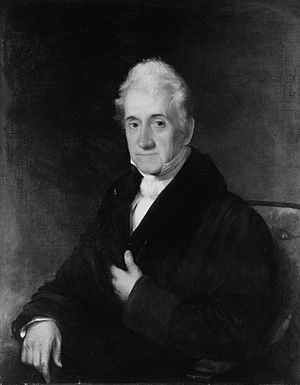
After the War of 1812, Stephen Van Rensselaer continued to serve on the Erie Canal Commission. Between 1820 and 1823, he paid for a study of the land around the canal. In 1820, he became president of the state Board of Agriculture. He also helped start the Albany Savings Bank and became its president.
In 1824, Van Rensselaer helped organize the Albany Institute. This group later joined with another to form the Albany Institute of History & Art. He was also active in the American Lyceum organization, which promoted public education.
Advocate for Higher Education
Stephen Van Rensselaer was a strong supporter of education. In 1794, he was elected to the board of Williams College.
In 1812, he helped start Albany's Lancaster School. This school provided education for children whose parents could not afford to send them to school. In 1813, he helped organize The Albany Academy and became the first president of its board.
He was a member of the University of the State of New York Board of Regents from 1819 to 1839. From 1835 to 1839, he was the board's chancellor.
In 1824, Van Rensselaer and Amos Eaton founded the Rensselaer School. Today, it is known as Rensselaer Polytechnic Institute (RPI). They started it to teach people how to use science in everyday life. RPI is now famous for its engineering programs.
He also served on the board of trustees for Rutgers College from 1829 to 1839.
Religious and Masonic Activities
Van Rensselaer was very active in the Dutch Reformed Church. He served as a deacon and elder at the First Reformed Church in Albany. He also attended many church meetings as a delegate. He was involved in the American Home Missionary Society and the American Board of Commissioners for Foreign Missions.
He was also an active Mason. From 1825 to 1829, he was the Grand Master of the Grand Lodge of New York.
Family Life
In June 1783, Stephen Van Rensselaer married Margarita "Peggy" Schuyler. She was a distant cousin and the daughter of Revolutionary War general Philip Schuyler. She was also the sister-in-law of Alexander Hamilton. They had three children, but only one lived to adulthood:
- Stephen Van Rensselaer IV (1789–1868): He inherited the eastern part of Rensselaerwyck. He graduated from Princeton in 1808. He later sold his townships during the Anti-Rent War.
After Peggy died in 1801, Stephen married Cornelia Bell Paterson in 1802. She was the daughter of William Paterson. Together, they had many children, including:
- William Paterson Van Rensselaer (1805–1872)
- Cortlandt Van Rensselaer (1808–1860): A well-known Presbyterian clergyman.
- Henry Bell Van Rensselaer (1810–1864): A politician and general in the Union Army during the American Civil War.
Stephen Van Rensselaer died in New York City on January 26, 1839. He was first buried in a family cemetery. Later, he was reburied at Albany Rural Cemetery.
Legacy and Honors
Stephen Van Rensselaer was one of the richest people in United States history. His wealth was estimated to be more than $100 billion in today's money.
The town of Stephentown, New York is named after him.
In 1791, he was made an honorary member of the New York Society of the Cincinnati. In 1822, Yale University gave him an honorary LL.D. degree. In 1998, the Rensselaer Polytechnic Institute added him to its Alumni Hall of Fame.
Images for kids
-
Artotype of Van Rensselaer's son, Stephen, by Edward Bierstadt, 1888
-
Van Rensselaer's son, Alexander, painted by George P. A. Healy, 1837
-
Van Rensselaer's daughter, Euphemia, painted by George P. A. Healy, 1842
-
Photograph of Van Rensselaer's son, General Henry Bell


